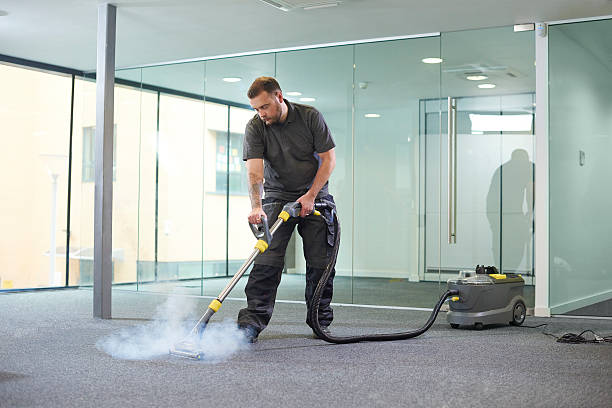Where does the dirt go when you steam clean?
When you wield the power of a steam cleaner, you’re not just moving dirt around; you’re obliterating it. Steam cleaning is not only about the removal of dirt, grime, and stains from our homes; it’s also about where that dirt ends up and how it’s handled in the cleaning process. With a deeper understanding of steam cleaning, commonly associated with steam mops and vapor steaming, you’ll come to appreciate its efficacy compared to traditional cleaning methods. This article will explore the scientific underpinnings of steam cleaners, the journey dirt takes once lifted from the surfaces, and why this method has become increasingly popular in professional cleaning services.
The Science of Steam Cleaning
Steam cleaning operates on a simple principle: using heat and water to create steam that loosens dirt and grime from various surfaces. The process often involves heating water to the point of creating water vapour, which is then directed onto the surface to be cleaned. This method leverages the muscle of steam pressure, not only to remove dirt but, by doing so, to kill bacteria and remove allergens as well.
Unlike detergents or scrubbing tools, steam cleaners work by harnessing the power of high-temperature steam to break down stubborn dirt and grime. The steam’s heat weakens the bond between the dirt and the surface, making it easier to wipe away or be drawn into the cleaner. Vapor steaming also reaches into nooks and crannies that might not be accessible through more conventional cleaning methods.
The versatility of steam cleaning does not limit its prowess to floors alone. It can be effectively used on other surfaces such as upholstery, carpets, and even bathroom fixtures. Its comprehensive capabilities could help reduce the need for multiple cleaning products, supporting a more environmentally friendly approach to household cleaning.

The Journey of Dirt During Steam Cleaning
The science behind removing dirt with steam is fascinating. As the steam cleaner releases hot vapor onto a surface, the tiny molecules of water vapour penetrate the dirt and grime. The heat from the vapor steaming then causes the dirt to loosen its grip, allowing it to be more effortlessly taken care of.
But doesn’t that mean moisture could be left behind? The design of steams cleaners typically includes mechanisms to extract the residual moisture, thereby ensuring that dirt is not just redistributed but indeed captured. During steam cleaning, the dirt either adheres to a cleaning cloth attached to the cleaner’s head, or it is sucked into the cleaner if it’s a steam vacuum configuration.
What’s important to understand is that the dirt goes from being firmly lodged on your surfaces to becoming part of the cleaning pad or being drawn into the steam cleaner’s reservoir. This system not only removes the visual eyesore of dirt and mess but, more crucially, it extracts the unseen germs and allergens that may pose health risks.
Best Practices for Effective Steam Cleaning
To ensure that steam cleaning is efficient and effective, certain preparatory steps are advised. Pre-cleaning rituals may seem tedious, but they set the stage for an optimal cleaning session.
- Mop or vacuum the area to pick up loose debris and dust.
- Pre-treat any stubborn stains to allow for easier removal upon steaming.
The crux of preparing surfaces for steam cleaning is to maximize the machine’s dirt removal capabilities. When a surface has less loose dirt, the steam cleaner can focus on breaking down the adhered grime, making for a deeper cleaning experience overall.
Troubleshooting Common Issues
Even with its robust cleaning powers, sometimes steam cleaning might not go as planned. Users might encounter challenges that prevent them from harnessing the full capability of their steam cleaner. Here are a few common problems and their solutions:
- Stains persisting after steaming: Sometimes, a stain requires a few passes before it can be fully removed. Persistent stains also benefit from pre-treatment with a mild detergent before steaming.
- Water spots left on surfaces: This can happen if the cleaner’s cloth pad is overly saturated, or the steam setting is too high for the surface being cleaned. Adjusting these accordingly can help.
Post-Cleaning Measures and Maintenance
After your surfaces have been steam cleaned, it’s essential to take certain post-cleaning measures to ensure the longevity of the cleanliness and the maintenance of the steam cleaner. Properly caring for both the cleaned surfaces and the equipment will ensure ongoing effective use and hygiene standards.
- Allow surfaces to dry completely: While steam cleaning leaves less moisture behind than other methods, it’s still important to let surfaces dry entirely to prevent mold and mildew growth.
- Ventilate the area: Open windows or use fans to circulate air and expedite the drying process.
Maintaining the steam cleaner is also vital to its longevity and effectiveness. After each use, empty and rinse out the water tank to prevent mineral build-up, check filters and replace them as needed, and store the unit correctly. Keeping your steam cleaner in tip-top shape ensures that each cleaning session is as efficient as the first.

Environmental Benefits of Steam Cleaning
One of the understated advantages of steam cleaning is its environmental impact—or rather, the lack thereof. Unlike many chemical cleaning agents, steam cleaning simply uses water and heat, which means it will not introduce harmful substances into your living space or the ecosystem.
| Benefit | Description |
|---|---|
| Reduces Chemical Use | Steam cleaning eliminates the need for chemical cleaning products, reducing the release of harmful substances into the environment. |
| Minimizes Water Usage | Compared to traditional cleaning methods, steam cleaning uses less water, conserving this valuable resource. |
| Improves Indoor Air Quality | By avoiding chemical cleaners, steam cleaning helps maintain cleaner indoor air, reducing pollutants that can harm health and the environment. |
| Non-Toxic | The steam cleaning process is non-toxic, making it safe for people, pets, and the planet by not leaving harmful residues. |
| Allergen Reduction | Steam cleaning effectively removes allergens such as dust mites and pet dander from surfaces without the need for chemicals. |
| Decreases Waste | By eliminating the need for disposable cleaning products and packaging, steam cleaning helps reduce solid waste. |
In households where chemical sensitivities are a concern, steam cleaning can be a godsend. It does not rely on potentially irritating cleaning agents, making it a friendlier option for those with allergies or pets. This method also aligns with a growing societal shift towards greener cleaning methods and sustainability.
Steam Cleaning: Myths vs. Reality
For all its advantages, there are several misconceptions about steam cleaning that need to be debunked:
– Myth: Steam cleaning is suitable for all types of surfaces.
– Reality: While steam cleaning is versatile, certain materials like delicate fabrics or unsealed flooring could suffer damage from high heat and moisture. Always consult the manufacturer’s recommendations.
– Myth: Steam cleaned surfaces are sterilized.
– Reality: While steam cleaning can kill a significant number of pathogens, it might not achieve sterilization. The effectiveness depends on the temperature and duration of exposure.

Conclusion
To wrap it all up, steam cleaning is much more than a simple clean-up; it’s a science that leverages high-temperature water vapor to do away with dirt. It effectively captures and eliminates the dirt and debris from your home, ensuring that when you steam clean, dirt goes not into the air or back onto your floors, but into the mechanism designed to eliminate it. Understanding the journey dirt takes during the steam cleaning process and following through with the proper pre- and post-cleaning practices can enhance the effectiveness of this method and provide you with a cleaner, healthier living environment.
FAQs
1. Can steam cleaning remove all types of dirt and stains?
Steam cleaning is very effective at removing a wide variety of dirt and stains. However, it might not be able to tackle some tough stains completely—especially those that have been on the surface for a prolonged period. Pre-treatment with a suitable cleaning agent could help address such stubborn stains.
2. How often should I steam clean my surfaces?
The frequency of steam cleaning depends on several factors including foot traffic, presence of pets, and personal cleanliness standards. As a general rule, high-traffic areas can benefit from a monthly steam clean, whereas less frequently used spaces might only require steam cleaning a few times a year.
3. Are steam cleaners safe to use on all materials?
No, steam cleaners are not safe for all materials. Surfaces like delicate silks, thin plastics, and certain types of hardwood flooring that haven’t been properly sealed might sustain damage from the heat and moisture of a steam cleaner. Always check the manufacturer’s instructions or test a small area first.
4. What should I do if dirt remains after steam cleaning?
If dirt remains after an initial steam clean, allow the surface to dry and then try steam cleaning again, focusing on the trouble areas. If the dirt persists, it may require a different cleaning technique or a stronger cleaning agent for pre-treatment.
5. Can steam cleaning damage surfaces or fabrics?
Steam cleaning can potentially damage surfaces or fabrics that are not designed to withstand high heat and moisture. Always be cautious and refer to the care instructions for the surface or fabric in question before proceeding with steam cleaning.



